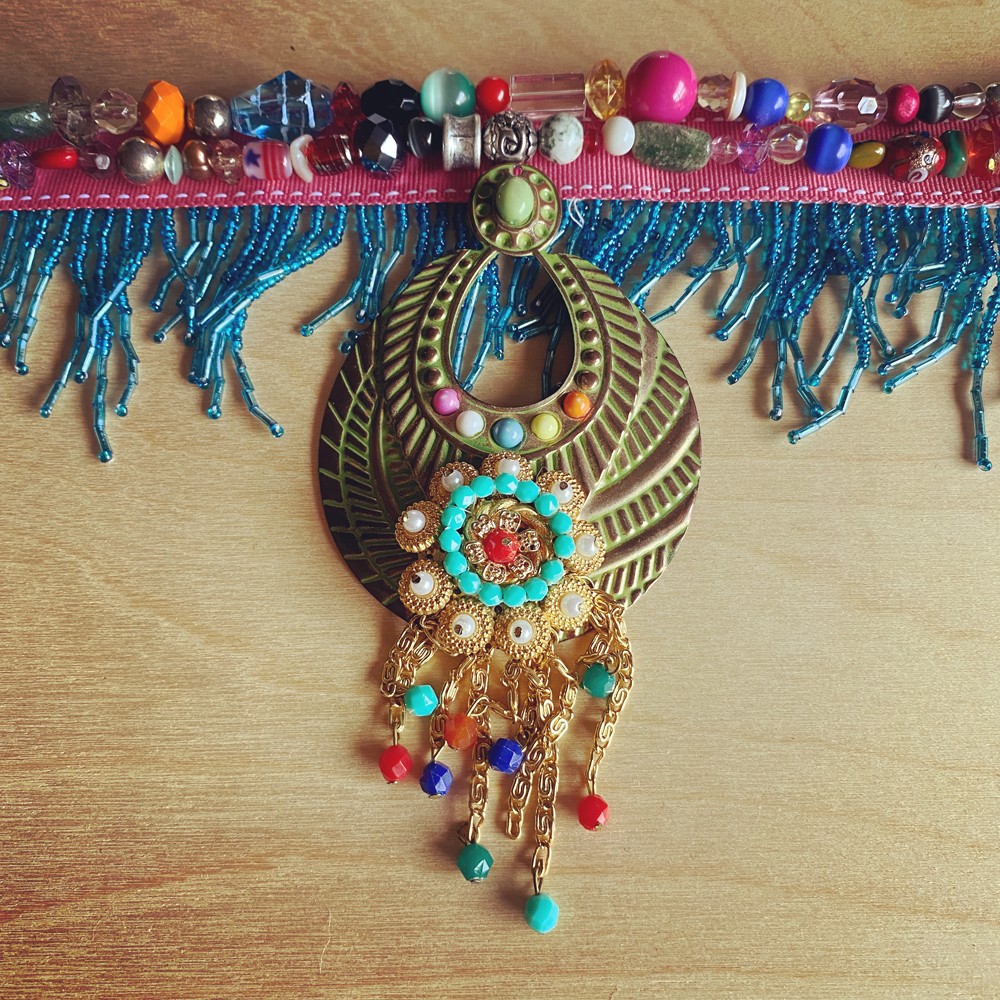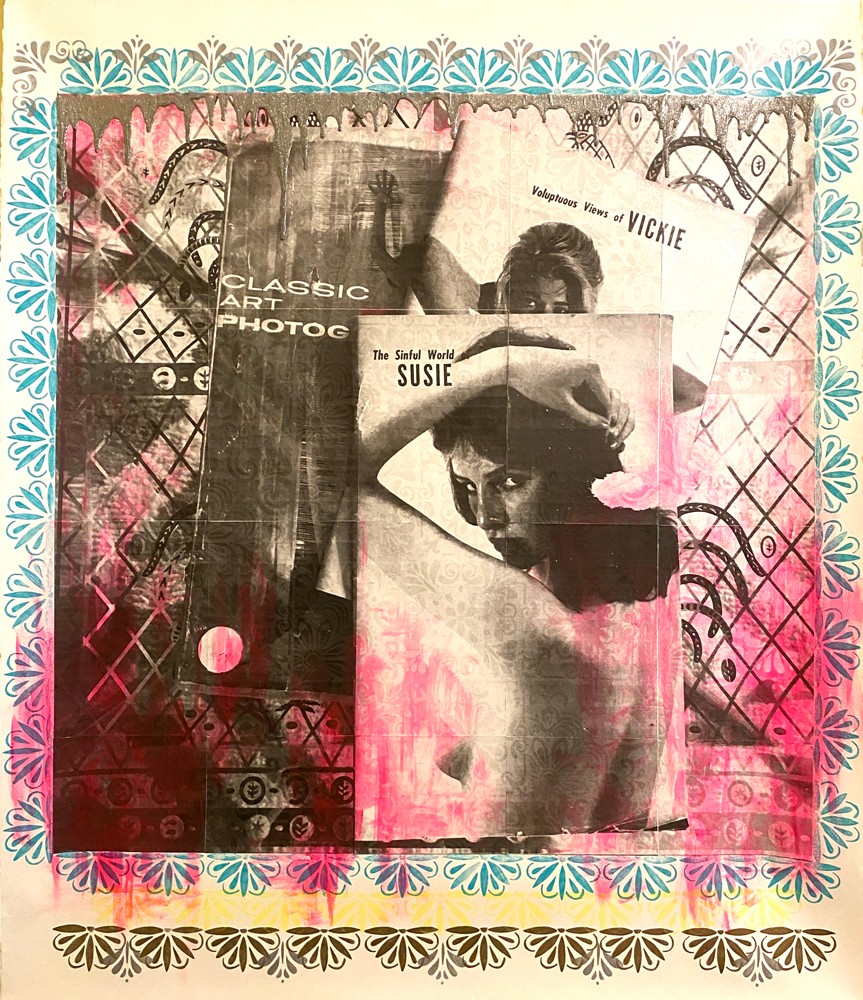We recently connected with Nicole Parker and have shared our conversation below.
Nicole, thanks for joining us, excited to have you contributing your stories and insights. What’s been the most meaningful project you’ve worked on?
Because of the nature of the art making process and my approach to education, from personal visual narratives to curriculum development for K-12+, there is always meaning in the work that I do. Educational curriculum includes cultural and historical components, along with the art making, to give context to each project. In the studio, materials used, imagery, and composition are planned out and analyzed. Something may just look pretty or fashionable, but peel away layers or spend time with a piece, a deeper meaning or symbol will emerge.
That being said, one of my favorite and most meaningful projects was shortly after I finished graduate school. I was an adjunct professor and a bartender and really did not have a big plan for the future outside of wanting to be a professional artist. I convinced a collective of male artists that I knew from school that they needed my skills in their move forward, from collective to nonprofit and into a larger space. The project was an artist run space that evolved into a nonprofit in Detroit, called 555. Taking on this project both combined and helped to develop my skills in all the mediums that I love; visual and performing arts, arts education, administration, and community development. It also helped to direct my path toward museum education and activism.
Along with volunteers, we rehabilitated a 13,000 square foot warehouse, formerly used for tent and awning manufacturing, into a vibrant community gathering space. Our renovations included the construction of eleven artist studios, three exhibition and performance spaces, offices, and a wood shop. We all had day jobs as well while we worked full time on the organization. As co-founder and director of development, I wrote grants, coordinated free after-school art workshops for youth, helped create our artist residency program, was outreach and volunteer coordinator, and learned how to drywall. We all wore many hats! I think my favorite part was being able to further promote, support, and uplift the artists in the Detroit arts community as well as working with neighbors in a safe and inclusive space. I also had a really beautiful studio space where I worked and collaborated with other artists who had studios at 555.


As always, we appreciate you sharing your insights and we’ve got a few more questions for you, but before we get to all of that can you take a minute to introduce yourself and give our readers some of your back background and context?
I came of age as an artist in Detroit where I trained in studio art and in nonprofit administration. My experience in Detroit informed my art making process, my approach to teaching, as well as a passion for community development and collaboration through the arts.
In Detroit, I was Assistant Professor and Gallery Director at Marygrove College, a small, private liberal arts college. I was also Co-founder and Director of Development of a small nonprofit arts organization, 555 Nonprofit Gallery & Studios. I moved to Austin in 2011 to be closer to family and for a change in environment. In Austin, I co-own and curate a mobile vintage and art gallery called Detroit to Laredo, where we exhibit local artists’ work and an eclectic mix of vintage and artisan objects, and I am the Culture and Arts Instructor /Residency Project Manager at The George Washington Carver Museum, Cultural and Genealogy Center.
I consider myself a mixed-media artist and a beginning jewelry artist. The 2-dimensional work that I create is largely based in photographic practices. Through paper collage, using a camera or creating a collage in Photoshop, the common thread of emotion, psychological space, or stillness runs through half of the pieces. The other half are sassy drawings or mixed media, fashionable characters that poke fun at themselves and the way that women often view themselves as fat, distorted, and ugly. Through the pandemic, I have really enjoyed still life and landscape photography due to being largely stuck at home and as a means to finding peaceful moments in chaos. During this same time, both the educational curriculum we were developing for museum programming and time alone for introspection inspired me to tell a visual story about the experiences and challenges I have had as a female artist. With a dash of humor and sarcasm, the new series called, “Portrait of an Artist as a Well-Trained Girl” explores the indoctrination of girls, sexuality, and sexism, the effects of these on intellect and self-esteem, and the unconscious biases and cultural norms that sustain traditions. The pieces are made up of original photographs, pencil, spray paint, varnish, and block prints.
The jewelry that I recently began making is made of broken and found pieces that I upcycle into new pieces. I have collected jewelry for years, inheriting my love for it from my great-grandmothers, my maternal grandmother, and my mother. We also sold vintage and resale jewelry at Detroit to Laredo so people were constantly donating necklaces, earrings, and loose beads to us. I plunged into upcycling after being accepted into a fashion show at the Austin Creative Reuse Center where I designed a skirt out of photograph “scraps” printed in the darkroom when I was in college. Styling for the fashion show included experiments in jewelry making as well as building a habit of using materials that already exist. As soon as I started making earrings, they were selling and it has taken off from there. It’s another way of finding and creating beauty and adornment in a time that feels very chaotic.


How can we best help foster a strong, supportive environment for artists and creatives?
From the beautiful to the grotesque, I believe in the transformative power of the arts. It is necessary in education for youth and adults and it is necessary for society. It is also very undervalued in the United States. The best thing that we can do is to stop cutting art programs, invest in art programs, investigate and be curious about art, become an arts advocate and speak to schools, city councils, and businesses, search out local arts and crafts instead of buying from box stores, attend an artist market, ask questions, visit an art gallery or museum, donate, hire creative thinkers, increase cultural workers’ incomes across the board, keep learning….open our minds…


Learning and unlearning are both critical parts of growth – can you share a story of a time when you had to unlearn a lesson?
Early in my career, I ran into a lot of negativity. It wasn’t critiques of my work, artists prepare as much as possible for critiques and reviews, but it was unsolicited critiques of my personality and my teaching methods. I had never had anyone question my honesty or competency except for in these academic settings. I always took pride in my honest and genuine nature, my work ethic, and abilities to do what I put my mind to, and I had an awesome group of students doing great things. It really caught me off guard and knocked me down for a bit. I also met challenges working with a group of male artists, being the only female in the leadership group of an organization. I was considered “one of the guys” until I wasn’t. I was sidelined and unheard on these occasions. The negativity and critiques were absorbed, I began to believe what colleagues had said, so it took a long time to bounce back and retrain myself to ignore that type of energy, to rebuild my mindset of strength, and to focus on my goals as an artist. From making art, writing grants, teaching youth, and coordinating outreach efforts to transforming a warehouse space into artist studios, gallery, and performance space, my focus has always been on the importance of the arts in community, in education as a vehicle for change, engaging multiple learning styles, and for social justice. I was not going to let this weird negativity stop me.
Contact Info:
- Website: nicoleparkerstudio.com
- Instagram: @nicoleparkerstudios
Image Credits
Nicole Parker


